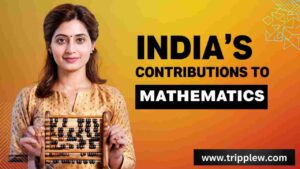
India’s Contributions to Mathematics
By Saumitra Chandra Pandey
India’s Contributions to Mathematics have profoundly shaped the global understanding of the subject. From the earliest periods of history, Indian mathematicians have introduced concepts and techniques that continue to influence modern mathematics, laying the foundation for numerous fields of study.
Invention of Zero and the Decimal System
The concept of zero, one of the most significant contributions of India, revolutionized mathematics. Aryabhata, an ancient Indian mathematician, played a crucial role in the development of the zero, which allowed for the creation of the decimal system. This system not only simplified mathematical calculations but also became a cornerstone for algebra, calculus, and computing in the modern world.
Aryabhata’s Contributions
Aryabhata, considered one of the greatest mathematicians and astronomers of ancient India, made substantial contributions to trigonometry, algebra, and arithmetic. His text, the Aryabhatiya, is known for introducing the approximation of π (pi) as 3.1416 and the concept of sine in trigonometry. His work inspired generations of scholars and mathematicians across the world.
Brahmagupta and Algebra
Brahmagupta, a 7th-century Indian mathematician, is credited with formulating rules for arithmetic operations involving negative numbers, zero, and algebraic equations. He expanded the use of zero, going beyond just a placeholder, and explored quadratic equations in his text Brahmasphutasiddhanta. His works laid the groundwork for future developments in algebra.
Srinivasa Ramanujan: The Mathematical Genius
In more recent history, Srinivasa Ramanujan stands out as one of India’s most brilliant mathematical minds. Ramanujan made extraordinary contributions to number theory, continued fractions, and infinite series. His work, recognized posthumously, has significantly impacted modern mathematics. His collaboration with the British mathematician G.H. Hardy led to some of the most remarkable results in the early 20th century, and Ramanujan’s theorems are still studied today.
Vedic Mathematics
Vedic mathematics is a system that simplifies complex calculations using 16 simple sutras (aphorisms). Originating from the ancient Indian scriptures called Vedas, this system focuses on mental calculations and shortcuts, making arithmetic faster and more intuitive. It continues to influence students and teachers who seek efficient methods for solving mathematical problems.
Kerala School of Mathematics and Calculus
The Kerala School of Mathematics, founded in the 14th century by Madhava of Sangamagrama, is credited with the early formulation of calculus. Long before Isaac Newton and Gottfried Wilhelm Leibniz introduced calculus in Europe, Madhava and his school developed infinite series expansions, including the approximation of π. This remarkable development shows India’s early understanding of mathematical concepts that would become essential in modern science.
Conclusion
India’s Contribution to Mathematics is not only a part of history but continues to resonate in modern academia. From zero to Vedic Mathematics, the achievements of Indian mathematicians have shaped the global framework of mathematics. This rich legacy serves as an inspiration, reminding us that mathematical innovation has been a key part of India’s intellectual heritage for centuries.
—
Disclaimer
The information provided in this blog is based on historical records, academic research, and widely accepted mathematical principles. The content aims to inform and inspire readers about India’s Contributions to Mathematics. However, the blog does not claim exhaustive accuracy and encourages readers to consult original sources or experts in the field for a deeper understanding. The views expressed by the author are his own, and Triple W holds no responsibility for any unintended inaccuracies.
Proud to be Indian 🇮🇷
Nice post 🏅